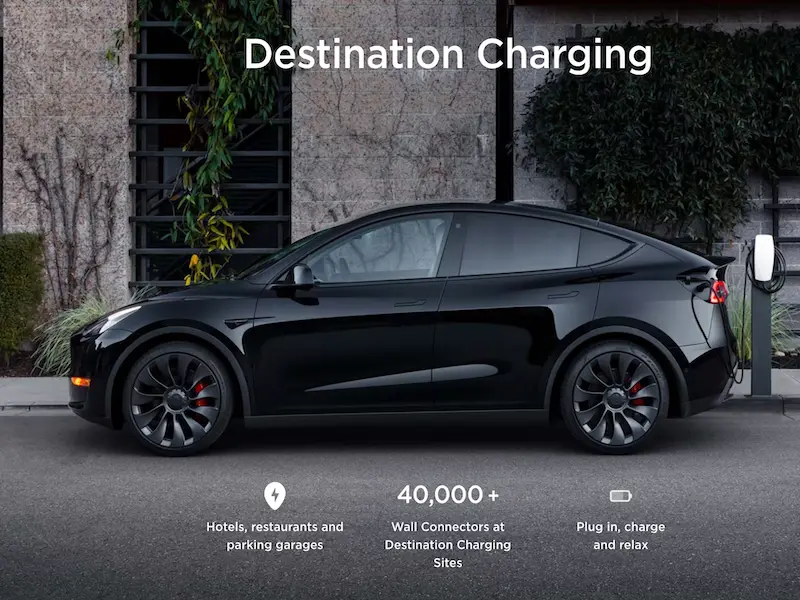- A Tesla destination charger is a type of charging station specifically designed for Tesla electric vehicles (EVs).
- Tesla destination charging allows Tesla vehicles to be charged while parked in a parking space, provided the space has a charger, whether it’s in a shopping centre, office, or restaurant.
- They are Level 2 chargers, meaning they charge far faster than a standard Level 1 “trickle” charger using a regular outlet but not nearly as fast as a supercharger.
- Tesla destination charging offers a win-win scenario for both Tesla owners and businesses, providing convenience, sustainability, and mutual benefits.
- They offer slower charging speeds compared to superchargers but are convenient for topping up a vehicle’s battery while parked for several hours or overnight.
- Non-Tesla EVs can also use destination chargers if equipped with an adapter that fits the Tesla plug.
A Tesla destination charger is a type of charging station specifically designed for Tesla electric vehicles (EVs).
Unlike Tesla superchargers, which are high-power stations primarily located along highways for long-distance travel, destination chargers are intended for use at hotels, restaurants, shopping centres, resorts, and other destinations where Tesla owners might spend an extended period.
What is a Tesla destination charger?
They are Level 2 chargers, meaning they charge far faster than a standard Level 1 “trickle” charger using a regular outlet but not nearly as fast as a Supercharger.
It’s different from superchargers, these chargers are typically installed by businesses to attract Tesla owners as customers or guests.
They deliver up to 11 kW of power, providing a convenient option for Tesla owners to recharge their vehicles while they’re away from home.
Tesla offers the destination charging programme to businesses interested in hosting these chargers, often providing support and installation at reduced or no cost.

How does destination charging work?
Tesla Destination Charging works by providing Tesla owners with a convenient way to recharge their vehicles while they’re away from home.
Here’s how it typically works.
1. Location: Tesla destination chargers are strategically placed at hotels, restaurants, shopping centres, resorts, and other destinations where Tesla owners are likely to spend an extended period.
2. Charging infrastructure: the destination charger consists of one or multiple charging units mounted on a pedestal or wall-mounted enclosure.
These chargers are hardwired to the electrical supply of the host location and may require an internet connection for monitoring and management.
3. Connection: Tesla vehicles are equipped with a proprietary connector, known as the Tesla Wall Connector, which is compatible with destination chargers.
When a Tesla owner arrives at a location with a destination charger, they simply park their vehicle within reach of the charger and connect it to their Tesla’s charging port.
4. Charging process: once the Tesla is plugged in, the destination charger delivers alternating current (AC) power to the vehicle’s battery.
The charger provides power at a rate of up to 11 kW, allowing the vehicle to recharge while the owner goes about their activities, such as staying overnight at a hotel, dining at a restaurant, or shopping at a mall.
5. Monitoring and management: Tesla destination chargers may be remotely monitored and managed by Tesla, allowing for software updates, maintenance, and troubleshooting as needed.
This ensures the reliability and performance of the charging infrastructure.
Also read: Tesla to build world’s largest supercharging station in Florida
How to find Tesla destination charging stations
Tesla’s destination charging stations are primarily located in cities where electric vehicles are prevalent. Tesla’s website gives a good indication of where they are located, You can search for nearby Destination Charging Stations based on your location or destination.
Additionally, you can also use third-party EV charging apps to find it. Apps like PlugShare, ChargePoint, or Electrify America offer comprehensive maps of EV charging stations, including Tesla Destination Chargers, along with user reviews and charging availability.
The difference between a Tesla supercharger and a destination charger
The main difference between a Tesla Supercharger and a destination charging station is four components, purpose and location, charging speed, and availability.
1. Purpose and location:
Superchargers are designed for long-distance travel along highways and major routes. They are strategically located for quick top-ups during road trips.
Destination chargers are positioned at hotels, restaurants, shopping centres, and other destinations where Tesla owners spend extended periods. They are intended for charging during longer stops, such as overnight stays or while dining/shopping.
2. Charging speed:
Superchargers provide high-power DC (Direct Current) charging, delivering up to 250 kW of power. This allows for rapid charging, with Tesla vehicles gaining significant range in a short amount of time.
Destination chargers offer slower AC (Alternating Current) charging, typically delivering up to 11 kW of power. While slower than Superchargers, they are suitable for longer stops where vehicles can charge over several hours.
3. Availability:
Superchargers are typically located at Tesla-owned or operated charging stations along major travel routes. They are less common in urban areas.
Destination chargers are found at a wide range of businesses and destinations, making them more prevalent in urban and suburban areas, particularly where Tesla owners are likely to spend time.
Who pays for the electricity at a Tesla destination charger?
The responsibility for paying for the electricity used at a Tesla destination charger typically falls on the business or property owner where the charger is installed.
When a business participates in Tesla’s destination charging programme and hosts a destination charger, they generally cover the cost of electricity as part of their operational expenses.
In some cases, businesses may choose to offer charging as a complimentary service to attract Tesla owners as customers or guests. Alternatively, they may incorporate the cost of electricity into the overall pricing structure of their services or amenities.
Also read: Tesla to adopt new assembly technology, reducing production costs
Can other EV cars use Tesla destination chargers?
Tesla Destination Chargers are designed specifically for Tesla vehicles and utilise Tesla’s proprietary charging connector. As a result, other electric vehicle (EV) models typically cannot directly use Tesla Destination Chargers without an adaptor.
However, there are adaptors available on the market that allow non-Tesla EVs to use Tesla Destination Chargers. These adaptors convert the Tesla connector to a standard connector compatible with other EVs, such as the J1772 connector commonly used in North America or the Type 2 connector used in Europe.
It’s important to note that using an adaptor may affect charging speed and compatibility, as Tesla Destination Chargers deliver power at a rate optimised for Tesla vehicles.
Benefits of Tesla destination charging
Tesla destination charging benefits both Tesla owners and businesses, providing convenience, sustainability, and mutual advantages.
Here are the benefits of Tesla destination charging.
1. Convenience: destination chargers are strategically located at hotels, restaurants, and other destinations, providing Tesla owners with a convenient way to charge their vehicles while they’re away from home.
2. Extended stays: unlike superchargers, which are primarily for long-distance travel, destination chargers are ideal for longer stops, such as overnight stays or extended dining/shopping trips.
3. Enhanced customer experience: businesses that offer destination charging demonstrate a commitment to sustainability and innovation, enhancing the overall experience for Tesla owners and potentially attracting more customers.
4. Partnership with Tesla: participating businesses can benefit from Tesla’s support and branding through the destination charging programme. Tesla may provide chargers at a reduced cost or even for free, enhancing the value proposition for businesses.
5. Promotion and visibility: businesses hosting destination chargers may receive promotion and visibility through Tesla’s website and mobile app, attracting additional customers who seek out locations with charging infrastructure.









